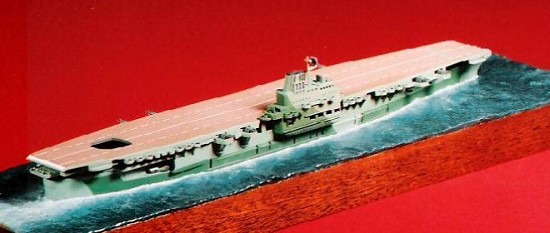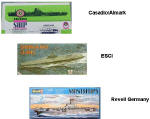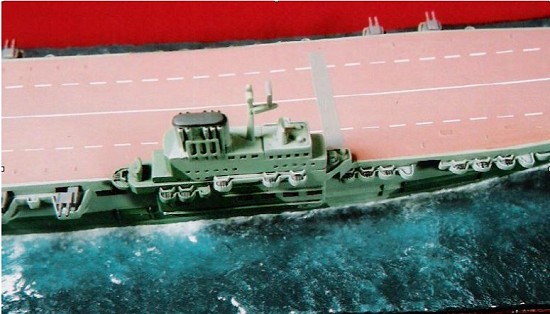
| KIT: | Revell AG 1/1200 IJN Shinano |
| KIT #: | 06816 |
| PRICE: | $3.75 |
| DECALS: | None |
| REVIEWER: | Tim Reynaga |
| NOTES: | Casadio/Almark/ESCI/MPC re-release |

| HISTORY |
The Imperial Japanese Navy carrier
Shinano
began life as the third Yamato class battleship. However, after the
devastating carrier losses in the Battle of Midway she was completed as a
flattop, the largest ever built until the USS Forrestal in the late
1950s. Possessing only a small air group of her own, Shinano was
intended to b e used as a
carrier task force support vessel. Her battlewagon ancestry and
armored decks were presumed to give her the ability to absorb massive
battle damage, enabling her to provide forward support the attack carrier
forces with fuel, stores, and extensive machine shops.
e used as a
carrier task force support vessel. Her battlewagon ancestry and
armored decks were presumed to give her the ability to absorb massive
battle damage, enabling her to provide forward support the attack carrier
forces with fuel, stores, and extensive machine shops.
She never got the chance. On November 29, 1944, while in transit for final fitting out from Yokosuka to Kure, Shinano’s starboard side was slashed open by six torpedoes from the submarine USS Archerfish. Had she been completely finished Shinano would probably have survived even this massive damage, but her full interior compartmentation had not yet been installed. After lingering for some six hours she went down suddenly, taking with her over 1,400 of her crew who had assembled on her flight deck waiting to be evacuated. She was just 20 hours into her maiden voyage.
| THE KIT |
A
recent release, Revell Germany’s Shinano is not a new molding. As
with other Revell 1/1200 MINISHIPS like the Hornet, Enterprise,
Missouri, and Yamato, it has been released variously over the
years by Casadio (also called "Mini-Ships") Almark,
 ESCI/ERTL, Model Power
Corporation (MPC), and probably others. This early 1970s model is a
simplified, snap-together kit engineered for quick building. Because of
the lack of information available on the Shinano I can’t comment
much on its accuracy, but it looks reasonable. The hull is recognizably a
Yamato class, and the outline does mostly match the handful of
surviving photographs. It has a stolid, chunky look reminiscent of
Tamiya’s old 1/700 scale offering. The only changes Revell has made over
previous versions of the kit were new box art and decals consisting of
three wide yellow lines for the flight deck.
ESCI/ERTL, Model Power
Corporation (MPC), and probably others. This early 1970s model is a
simplified, snap-together kit engineered for quick building. Because of
the lack of information available on the Shinano I can’t comment
much on its accuracy, but it looks reasonable. The hull is recognizably a
Yamato class, and the outline does mostly match the handful of
surviving photographs. It has a stolid, chunky look reminiscent of
Tamiya’s old 1/700 scale offering. The only changes Revell has made over
previous versions of the kit were new box art and decals consisting of
three wide yellow lines for the flight deck.
Though simplified, the kit has a number of thoughtful design features. One
is the lowered aft elevator through which you can see a little of the
hangar deck. I also liked the open hangar deck side doors, a feature
absent even on most larger scale model carriers. Realistically, these
enable the viewer to actually see completely through the hangar deck in
places. Very cool. There are also some open panels (intakes?) on the
island outboard sponson which add a sense of depth and complexity to the
model. Even the bridge windows are see-through! These touches do a lot to
offset the model’s toylike appearance. Raised porthole and scupper details
seem a little heavy, but at 1/1200 I suppose they would be nearly invisible
if done in-scale; the more delicately rendered flight deck details nearly
disappeared once painted.
| CONSTRUCTION |
The model was snap-together simplicity, and it went together easily for
the most part. I had a bit of difficulty getting the flight deck to
lie flat onto the hull, but widening the large locator holes took care of
this. Parts had a lot of fla sh,
but that’s not unusual for such an old molding. After clean up, I
filled in the locating holes for the aircraft on the flight deck. Though
the unfinished ship never carried them, the model comes with a small air
group. Unfortunately the planes provided are not very realistic,
unrecognizable as any specific type. I glued them to the flight deck
from the underside, so the pegs in them filled those awful locator holes in
the flight deck above.
sh,
but that’s not unusual for such an old molding. After clean up, I
filled in the locating holes for the aircraft on the flight deck. Though
the unfinished ship never carried them, the model comes with a small air
group. Unfortunately the planes provided are not very realistic,
unrecognizable as any specific type. I glued them to the flight deck
from the underside, so the pegs in them filled those awful locator holes in
the flight deck above.
The numerous triple 25mm guns were molded directly onto the galleries, but don’t look bad. The larger 127mm guns, molded as separate units, are simplified but acceptable in this tiny scale (the model is less than 9 inches long). Strangely, the aircraft handling crane is a duplicate of that found in the battleship Yamato kit. Completely wrong for Shinano, I tossed it. The ship’s boats, also from the Yamato kit, are pretty good.
This was an out of the box build, so it went together quickly. Even with flash clean up, assembly took maybe half an hour, if that.
| COLORS & MARKINGS |
 The reason I chose to build this simple Shinano kit was for the fun
paint job. I had read
that, strange as it may
seem, the flight deck of the Shinano was a very un-military shade of
pink! (The box art from the old Tamiya 1/700 scale model actually
depicts this.) According to Lynn Lucious Moore's “Shinano: The Jinx
Carrier” (US Naval Institute Proceedings, February, 1953) the
steel flight deck was covered with, “...a thin, shock-absorbent
latex-sawdust...” composition. The origin of the wood is unclear, but
Japanese red cedar (sugi) or Japanese red pine (akamatsu),
both common in Japan, would account for the pinkish color noted by
observers. The deck would have undoubtedly have been camouflaged before
she entered service, but it had not yet been done when Shinano was
sunk on her way to final fitting out. The improbable color is well
attested by several eyewitnesses, both former crewmen and civilian
workers. The original Japanese source for this information (a well known
industrialist) had been a civilian worker on the Shinano in 1944.
His potentially embarrassing revelation was at first quite controversial in
Japan, but eventually other observers came forward confirming his unusual
story.
The reason I chose to build this simple Shinano kit was for the fun
paint job. I had read
that, strange as it may
seem, the flight deck of the Shinano was a very un-military shade of
pink! (The box art from the old Tamiya 1/700 scale model actually
depicts this.) According to Lynn Lucious Moore's “Shinano: The Jinx
Carrier” (US Naval Institute Proceedings, February, 1953) the
steel flight deck was covered with, “...a thin, shock-absorbent
latex-sawdust...” composition. The origin of the wood is unclear, but
Japanese red cedar (sugi) or Japanese red pine (akamatsu),
both common in Japan, would account for the pinkish color noted by
observers. The deck would have undoubtedly have been camouflaged before
she entered service, but it had not yet been done when Shinano was
sunk on her way to final fitting out. The improbable color is well
attested by several eyewitnesses, both former crewmen and civilian
workers. The original Japanese source for this information (a well known
industrialist) had been a civilian worker on the Shinano in 1944.
His potentially embarrassing revelation was at first quite controversial in
Japan, but eventually other observers came forward confirming his unusual
story.
The hull color was also interesting.
Shinano
renderings (including the
Revell AG box art) almost always show her in basic IJN gray overall.
However, a photo of her taken as she was conducting steering trials in
Tokyo Bay shows that she actually carried a two-tone camouflage. This was
almost certainly the IJN "Type 2 Hull
Color" scheme of light/medium greens 2 and
 21, a pattern used as an
anti-submarine measure on other late war Japanese carriers. The idea was
to make the high-value carrier look like a humble tanker or merchantman
from a distance. (Evidently it was effective: the captain of the
Archerfish initially mistook Shinano
for a tanker.)
21, a pattern used as an
anti-submarine measure on other late war Japanese carriers. The idea was
to make the high-value carrier look like a humble tanker or merchantman
from a distance. (Evidently it was effective: the captain of the
Archerfish initially mistook Shinano
for a tanker.)
Pink and green…I just had to give that outlandish scheme a go! The hull colors were, fortunately, readily available from White Ensign Colourcoats. Based on the trials photo I sketched out and applied the pattern using White Ensign IJN06 Type 2 Camouflage Green and IJN07 Type 21 Camouflage Green. The greens turned out to be vivid and attractive, a stunning departure from the usual. For the flight deck I mixed my best-guess version of mauve/pink. No airgroup was ever embarked, but a few landing tests were conducted, so I felt justified in adding “temporary” white lines to break up that plain deck. The kit decals seemed too wide, so I substituted 1/64 inch white dry transfer lines from Woodland Scenics.
| CONCLUSIONS |
I’m not a big fan of snap together models, but I have liked this little kit since I first built the MPC version of it when I was a kid. It is simplified and a little basic, but it builds quickly into something that looks reasonably like a Shinano.
I can honestly say that this is the best looking pink and green aircraft carrier in my collection!
December 2005
If you would like your product reviewed fairly and quickly by a site that has around 300,000 visitors a month, please contact me or see other details in the Note to Contributors.